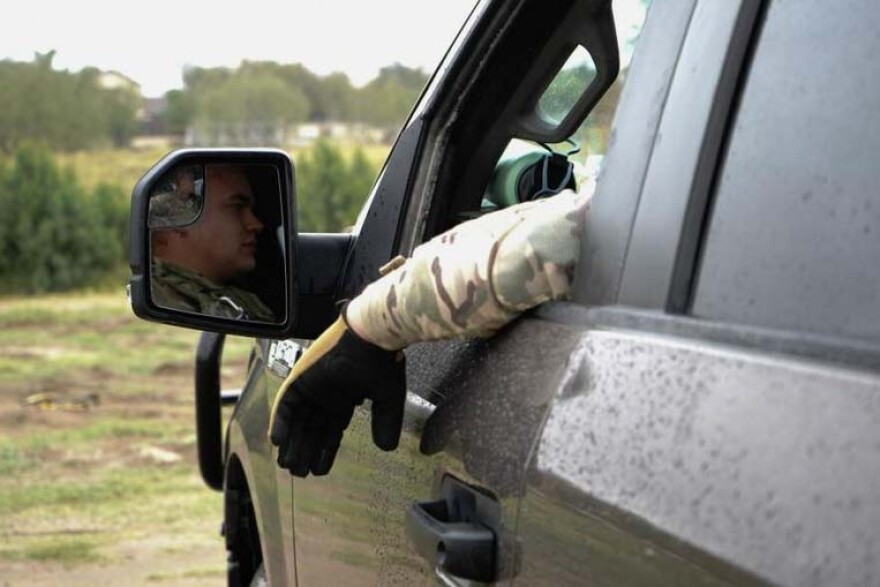For military personnel at the U.S.-Mexico border, including National Guard troops, it's an unusual assignment. Many are quartered in hotels, and their families are allowed to visit.
In a darkened room inside the McAllen, Texas Border Patrol station, National Guard troops are bathed in violet glare. In front of them is a wall of screens, each displaying camera feeds from different parts of the border.
Machines beep intermittently and fuzzy radio transmissions echo throughout the room.
Using motion sensors and control towers, the Guardsmen can see vehicles, terrain, and occasionally people. If they spot something suspicious, like someone who may be hauling drug bundles or trying to cross the border illegally. they report it to the Border Patrol.
The McAllen border patrol station's area of responsibility is broken up into east and west. Teams of Guardsmen monitor both sides and try to outdo one another with sightings.
"It's kind of a competition. Whoever calls it out first," said border patrol agent Juan Reyna, who works alongside the National Guard in the tactical operations center.
"For us to make it fun here, we usually let them know, like, 'Hey yesterday west side beat you guys. So come on, east side, you've got to come up with bodies this time around.'"
Along the border itself, National Guard personnel also operate scope trucks -- pickups with raised cameras -- to monitor border activity. They also clear roads for the Border Patrol, help fix their equipment, and perform administrative tasks.
But military personnel do not confront or apprehend suspects. That job is left to the Border Patrol.
"We're filling crucial gaps for Customs and Border Protection - for Border Patrol - in certain locations here," said Maj. Mike Perry, a public affairs officer with the Texas National Guard. "We're here so they can focus on their law enforcement job."
"We provide infrastructure, operational and aerial support, information and detection," he said.
Since 2014, National Guard troops have been a regular presence on the U.S. southern border. There are now some 1700 troops in Texas alone - about 1600 from the Army National Guard and about 100 from the Air National Guard. Support includes personnel from Texas, Nebraska, Utah, Mississippi, Kentucky, Georgia, South Carolina, Alabama, Arkansas, Oklahoma and Iowa.
It's unclear how often Guardsmen actually contribute to Border Patrol apprehensions - or whether their presence has helped drive down the number of crossings. Since troop levels ticked up in April 2018, the number of migrant crossings has fluctuated widely, partly in response to seasonal shifts and federal policy changes.

Not Your Typical Deployment
Guardsmen stationed along the border live in government-contracted housing during their deployments, which usually last a few months. For most, that means staying in hotels, which are covered by a per diem of about $150.
One February morning in Hidalgo County, several uniformed Guardsmen ate a continental breakfast at a La Quinta Inn that's become their temporary home. Some watched political news on a TV in the dining room as other guests served themselves bacon, eggs, and tamales.
Hotel staff say they've gotten to know these Guardsmen, and they've seen different groups cycle through over time. An appreciation plaque with a National Guard insignia hangs behind the hotel desk.
In their off time, members of the Guard blend into the community.
For Jason Martinez, a gym owner in Mercedes, Texas, the Guardsmen are a welcome presence. He has an arrangement with the hotel next door to accommodate troops who are staying there.
Martinez said he often sees them working out in groups. He gestured to a bank of cardio machines behind him.
"You've got your treadmills, steppers, ellipticals, arc trainers," Martinez explained. "I've seen them. One time they were all over there running."
"Definitely a Big Change"
In November 2019, members of the Georgia Army National Guard, including Lt. Ashton Griffith, deployed to the border as part of an all-volunteer task force in support of U.S. Customs and Border Protection.

Griffith came back from Afghanistan last year and has also helped with hurricane relief efforts in his home state.
"It's definitely a big change," he said of the border assignment.
Griffith's unit initially had some concerns about coming to Texas. But he said they opened up to it when they learned more about the job - and were told their families could come visit from time to time.
For some Guardsmen, part of the border mission's appeal is the military experience it gives them. Many of those who deploy take on responsibilities normally reserved for those of higher rank and learn how to coordinate between different federal agencies.
"Coming here was a broadening assignment for them," Griffith said. "They get to learn how the federal government operates, and it also helps them accrue some time and some experience down here in Texas. That'll help them, not only here, but in their military career."
Griffith, who works in local law enforcement when not on orders, said life at the border isn't what he expected.
"You think, man, this is Texas. It might be desert. You won't have a lot of things to do," he said. "But when we came out here to this community, it was well built up. You have so many attractions to come and stay in the area … This is a wonderful place to be."
The word is getting out, Griffith said, and more Guardsmen want to come to the border to serve.
This story was produced by the American Homefront Project, a public media collaboration that reports on American military life and veterans. Funding comes from the Corporation for Public Broadcasting.





